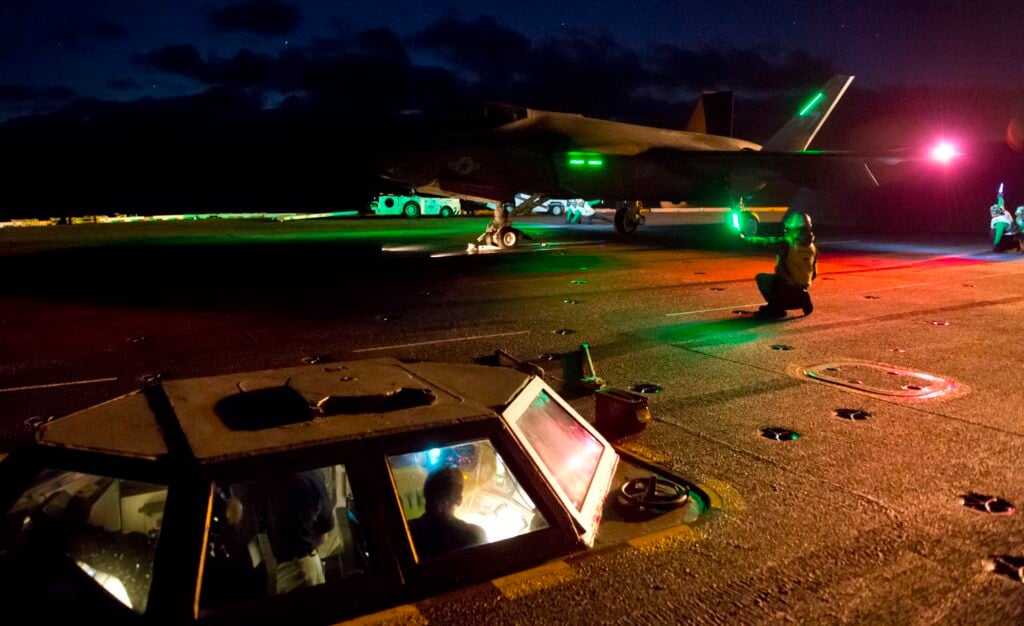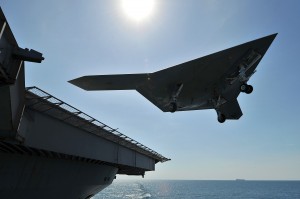Navy Must Boost Carrier Air Wings’ Range, Size & Lethality
Posted on

F-35C night takeoff from USS Nimitz
Paris Air Show attendees take note. The Navy needs more new strike fighters to cope with falling readiness rates. Will they be Super Hornets, F-35s or Block III Super Hornets? What mix does the US Navy need as it grapples with boosting the size of the fleet to 355 ships? And what about the MQ-25 Stingray: Should it be a tanker or a bomber or change over time? Jerry Hendrix, the well-connected naval expert at the Center for New American Security explores these issues and more. Read on! The Editor.
Congressional leaders, DoD policy makers, and think tank denizens in the age dominated by the strategic goal of reaching 355 ships, risk losing focus on the other critical challenge facing the Navy today: improving the carrier air wing.
Currently the air wing faces three significant challenges that places the carrier’s relevance in jeopardy. First, the its ability to penetrate newly emerging Anti-Access/Area Denial (A2AD) environments increasingly populated by advanced Russian S-400 and Chinese HQ-9 surface to air missiles is challenged. Second, naval aviation faces a shortfall of 100 aircraft that is causing it to burn through planes faster than they are being replaced. Lastly, the air wing lacks the range to reach its targets as the carriers are pushed farther from shore by new anti-ship cruise and ballistic missiles. If the Navy does not make significant investments in its carrier air wings, then the super carrier, the naval asset that puts the “power” in power projection and most epitomizes modern American military might, risks being rendered irrelevant.

Jerry Hendrix
Fortunately, the Navy is already working on a partial solution for the A2AD environment challenge. The carrier variant of the Lockheed Martin’s stealthy Joint Strike Fighter, the F-35C, is designed to operate with some effectiveness within high threat environments populated with advanced surface to air missile systems. The Department of the Navy intends to purchase 340 F-35Cs, 260 for the Navy and 80 of the Marine Corps. These aircraft will combine to place two F-35C squadrons of 10 aircraft on every deploying American super carrier. In addition, the Marine Corps will purchase 340 of the Short Take-Off Vertical Landing (STOVL) F-35B variant of the new aircraft, which will operate from shore bases and smaller amphibious carriers. The Navy’s goal is to have the F-35C reach Initial Operating Capability (IOC) in February 2019.
The Navy’s leadership has also recognized the critical nature of its strike fighter shortfall. Each aircraft in the inventory is rated to have only so many hours of wing-life, 6,000 hours for FA-18s originally, but later revised upward to 8,000 hours, but high tempo operations over the past 15 years of warfare have burned through those hours well ahead of schedule, leading to aircraft being stricken from the inventory long before force planners expected them to retire. These leave fewer aircraft which are called upon to fly more to make up shortfalls, hence accelerating the burnout rate, leading to what programmers call a systemic “death spiral.” Today naval aviation has around 100 fewer aircraft than it needs, and the Navy had not planned to buy additional FA-18 E/F Super Hornets. The retiring aircraft were supposed to be replaced by F-35Cs.
Fortunately, leaders in the Pentagon and on Capitol Hill have seen the light and plan to buy at least 80 more FA-18s over the next five years. Some of these will be the existing FA-18 E/F variant, but some farther into the schedule some could be Boeing’s new “Block III” Hornet, which would come with range-extending external fuel tanks, expanded weapons payload and new integrated sensor/shooter combat systems.
The extended range will be critical. Much has been written in the past about the fact that the carrier air wing’s average striking range has shrunk from 900 to 500 nautical miles over the past 25 years while China and Russia have invested in new A2AD systems such as the carrier killing DF-21 missile, designed to keep the super carriers from coming within 1,000 miles of their shores in war time. Future air wings composed of F-35Cs, which have an unrefueled combat range of 630 nautical miles, and Block III FA-18 Hornets, which, with their conformal fuel tanks carrying an additional 3,500 lbs. of fuel, could reach out to 750 miles. However, neither of these alone can bridge the gap imposed by enemy A2AD systems. To reach enemy targets, the carrier will need to bring a mission tanker back to the flight deck.
Mission tankers, as opposed to smaller capacity recovery tankers, have been in the Navy since the 1950s, when the concept of being able to fully refuel a strike package composed of multiple aircraft near their maximum range first appeared. During Vietnam, a modified 85,000 lb. A-3 Skywarrior would be launched early from the carrier carrying nearly 30,000 lbs. of fuel which it transferred to A-4s, A-7s and A-6s, topping them off before they continued towards targets in Vietnam, Laos and Cambodia. These aircraft were retired in the early 1990s but they left a memory and a metric. The ability to fully refuel a strike package near its maximum unrefueled range.

The X-47B drone
Today a strike package sent into an A2AD environment would almost certainly be comprised of F-35Cs being supported by FA-18 E/F Super Hornets and EA-18G Growler jamming aircraft. The mission tanking requirement would be centered around a basic goal of being able to fully refuel six to eight F-35Cs near the 500 to 600 nautical mile range from the carrier. Given the fuel burn rates associated with Pratt and Whitney’s F135 engine, each aircraft would require a little over 8,000 lbs. of fuel to top off in the 500-600 nautical mile refueling zone. Working from this math, the planned new unmanned MQ-25 Stingray mission tanker should be able to carry the 16,000 to 17,000 lbs. of fuel for transfer to other carrier aircraft at the critical range. Four MQ-25s (80% of a squadron of five) would be required for a six-to-eight aircraft mission package to be able to reach and attack targets over a thousand miles from the carrier, keeping the large platforms both survivable and relevant.
There are other issues that will confront the carrier air wing. For instance, during the 1980s aircraft carriers carried more than 80 aircraft of various designs to do specific missions. F-14 Tomcats (of TOPGUN fame) performed long-range intercept, A-6 Intruders did long-range strike, S-3 Vikings performed anti-submarine patrols ahead of the carrier’s intended path. Other aircraft included the A-4 Skyhawk, the A-7 Corsair II, the E-2 Hawkeye, the HS-3 Sea King helicopter and the KA-3 Sky Warrior mission tanker. These aircraft were focused on projecting power far from the carrier, but today’s air wing hovers around 60 aircraft and is largely made up of strike fighters that were designed to be replacements for shorter range, light attack aircraft of the past.
The air wing needs to procure an anti-submarine warfare aircraft as well as a purpose-built penetrating deep strike aircraft. It would be wise if the Navy structured the requirements for the MQ-25 tanker, something built to carry a heavy load a long distance, to allow it to evolve into an all aspect, low radar cross section, long range penetrating bomber. This would provide the Navy once again with the ability to strike targets ashore within future A2AD environments.
Today the Navy leadership’s focus is largely — and justifiably — on the need to build its battle force back up to 355 ships to protect the nation’s national interests around the world. Some leaders have chosen to focus on the need for more fast attack submarines, while others have highlighted the need to get a robust frigate into the fleet in large numbers. Still others have raised the issue of maintaining the nation’s shipyards in order to ramp up future production.
But without a large enough, lethal enough and long-range carrier air wing, the super carrier will not be the preeminent symbol of its national power. If the aircraft are not capable of penetrating the enemy’s advanced defenses, if there are not enough of them to sustain the fight, or lack the basic mission tanking ability to enable them to reach their targets, then all other basic assumptions regarding American naval power are placed in doubt. Given the nature of international competition today, doubt is not a word the nation should wish to have associated with its Navy and its Navy’s carriers.
Subscribe to our newsletter
Promotions, new products and sales. Directly to your inbox.
